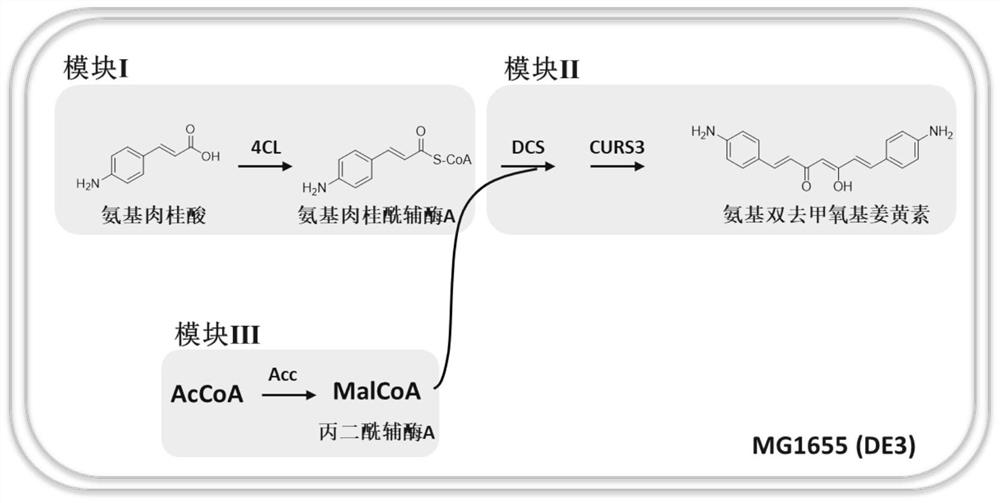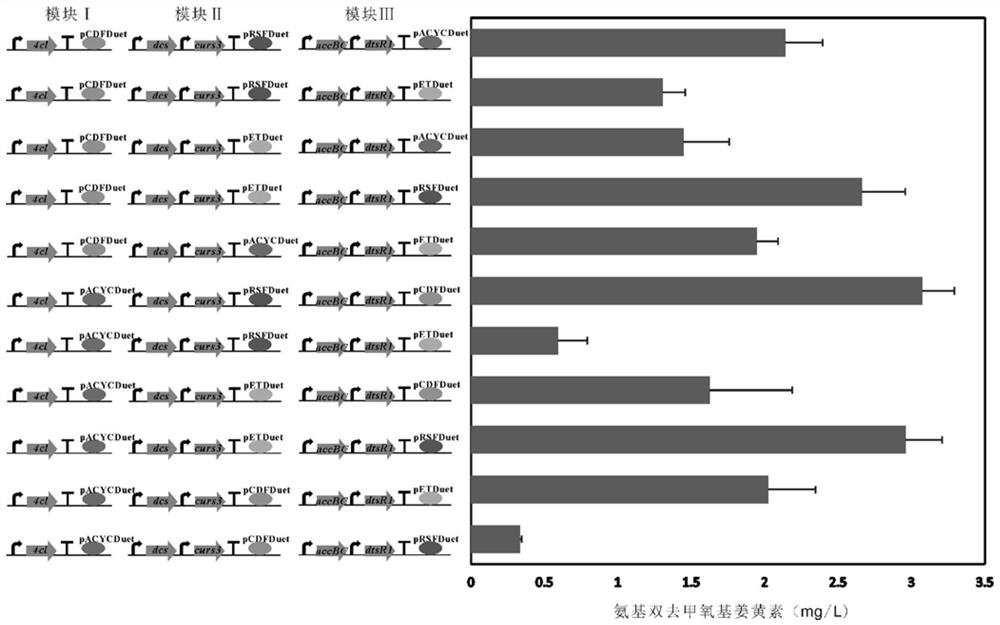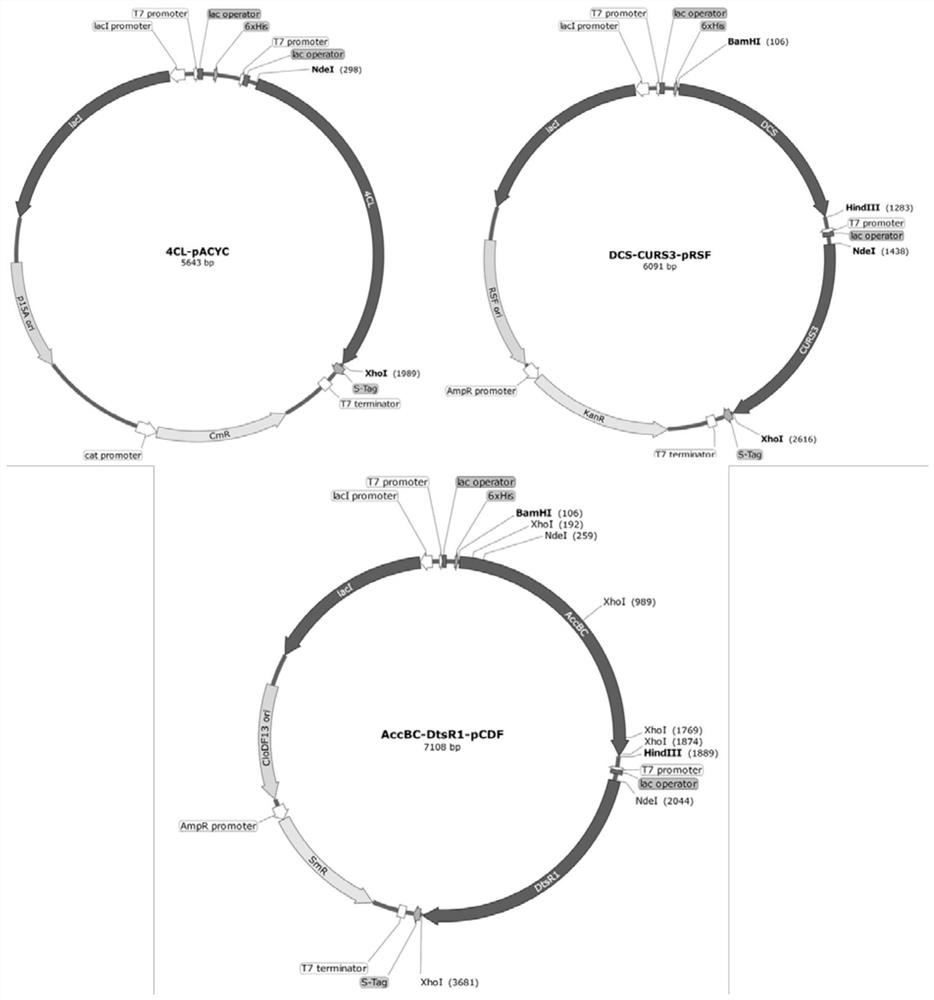Construction and fermentation optimization method of amino-bis-demethoxycurcumin high-yield strain
A kind of technology of demethoxycurcumin and aminobis, applied in the field of metabolic engineering
- Summary
- Abstract
- Description
- Claims
- Application Information
AI Technical Summary
Problems solved by technology
Method used
Image
Examples
Embodiment 1
[0036] Embodiment 1, construction and module division of aminobisdemethoxycurcumin synthetic pathway
[0037] In the biosynthetic pathway of curcumin, dimeric ketone synthase DCS and curcumin synthase CURS can use two molecules of coumaryl-CoA and one molecule of malonyl-CoA as substrates to synthesize a molecule of bis-nor Oxycurcuminoids. The present invention intends to use p-aminocinnamic acid as a feeding substrate in order to obtain aminobisdemethoxy curcumin. Therefore, the present invention plans the whole biosynthetic pathway into three modules ( figure 1 ). Module I contains the 4-coumaroyl-CoA ligase gene 4cl from Arabidopsis, which encodes a 4CL protein that converts the substrate p-aminocinnamic acid to aminocinnamoyl-CoA. Module Ⅱ contains dimeric ketone synthase gene dcs and curcumin synthase gene curs3 from turmeric, which is the core module of curcumin synthesis. Module III contains the acetyl-CoA carboxylase gene (including two genes, accBC and dtsR1) f...
Embodiment 2
[0040] Embodiment 2, the construction of modular engineering bacteria
[0041] The above five genes were codon-optimized in Escherichia coli and fully synthesized. Construction of module I: 4cl was ligated with pACYCDuet vector digested with NdeI and XhoI to construct plasmid 4CL-PACYC. Construction of module II: connect dcs and curs3 to pRSFDuet vector digested with BamHI, HindIII, NdeI and XhoI to obtain plasmid DCS-CURS3-pRSF. Construction of module III: Refer to the construction of module II to construct the plasmid AccBC-DtsR1-pCDF. For the schematic diagram of each plasmid, see image 3 . The three recombinant plasmids were co-electrotransformed into MG1655(DE3) competent cells, and screened on LB solid plates containing 50 μg / mL spectinomycin, 50 μg / mL kanamycin and 25 μg / mL chloramphenicol. The grown single clones were verified by PCR to ensure the correctness of the positive clones ( Figure 4 ). The recombinant strain obtained from the final screening was nam...
Embodiment 3
[0044] Embodiment 3, fermentation produces the method for amino bis-demethoxy curcumin
[0045] The recombinant strain HXJE109 obtained in Example 2 was inoculated in LB liquid medium, and after culturing overnight at 37°C, it was inoculated in 100 mL of fresh LB liquid medium at an inoculation ratio of 1:100. Cultivate to OD at 37°C and 220rpm 600 When ≈0.6, add 0.5mM IPTG and 0.5mM p-aminocinnamic acid at a final concentration, turn to 25°C, 220rpm and continue culturing for 48h. Take 500 μL of fermentation broth, add 500 μL of methanol, mix well, and then ultrasonically disrupt the bacteria. Centrifuge at 12000rpm for 5min, and take the supernatant for HPLC detection. Use 4.6μm×250mm Agilent TC C18 reverse-phase column, use 0.1% formic acid water as phase A, pure methanol as phase B, flow rate 1mL / min, carry out elution according to the following conditions: 0min, 10% B; 9min, 100% B; 15 min, 100% B. The detection wavelength is 450nm. The final calculation shows that...
PUM
 Login to View More
Login to View More Abstract
Description
Claims
Application Information
 Login to View More
Login to View More - R&D
- Intellectual Property
- Life Sciences
- Materials
- Tech Scout
- Unparalleled Data Quality
- Higher Quality Content
- 60% Fewer Hallucinations
Browse by: Latest US Patents, China's latest patents, Technical Efficacy Thesaurus, Application Domain, Technology Topic, Popular Technical Reports.
© 2025 PatSnap. All rights reserved.Legal|Privacy policy|Modern Slavery Act Transparency Statement|Sitemap|About US| Contact US: help@patsnap.com



